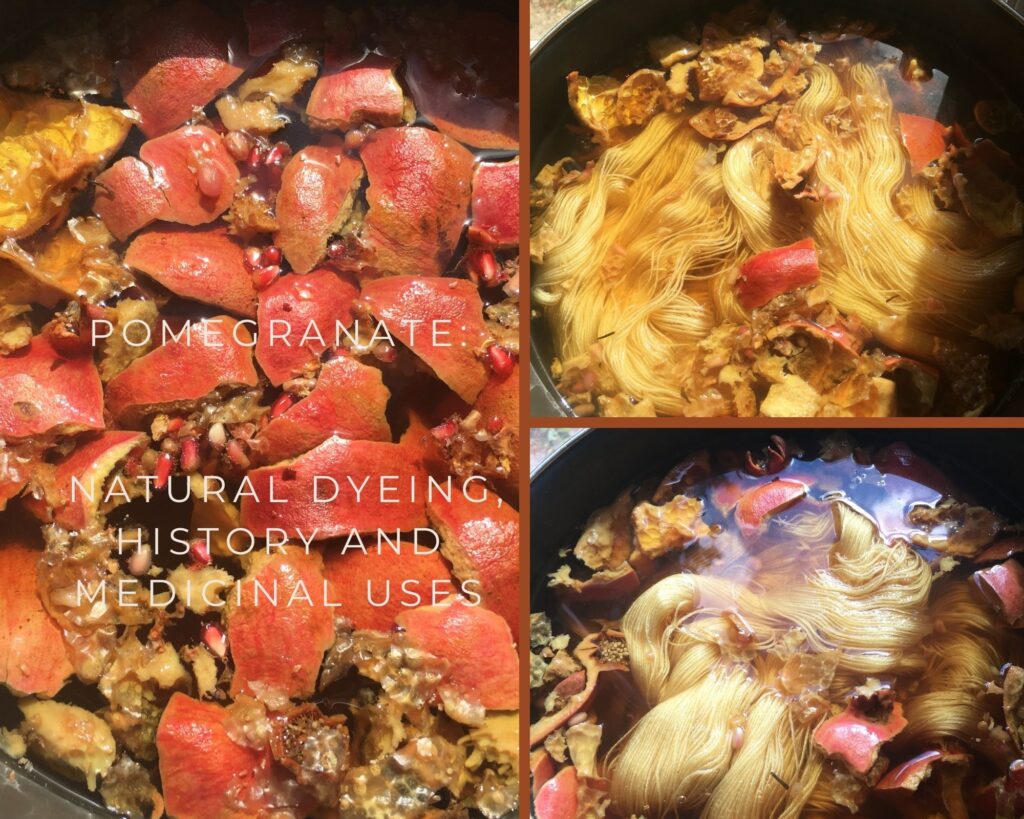
The pomegranate, through natural dyeing, history and medicinal uses, is today’s focus!
After our article about the history, medicinal and dye uses of the walnut tree, we decided to continue our series with the pomegranate. It’s been a popular fruit through history and can be found as a symbol in several religions, dozen of myths and as a widely used pattern in art. It’s no wonder since the pomegranate is excellent for your health but has been used for natural dyeing for centuries.
Let’s go through its history and uses together! Then get ready for another natural dyeing recipe.
Pomegranate is popular for natural dyeing but first, let’s start with some history
The uses of Pomegranate through history
First, let’s start with some botanical facts
The encyclopedia Britannica tells us that the pomegranate tree is small and can sometimes be called a shrub. From its orange red-flowers come our pomegranate fruits, as large as big oranges.
Pomegranate belongs to the Berry group, along with bananas, cucumbers and aubergines whereas strawberries and raspberries don’t. Its tree is highly resistant to drought and can live forever (well up to 200 years).
Pomegranate’s genus name Punica Granatum (Punica being the name Romans gave to Carthage) was given by the Romans because they thought pomegranates came from Africa.
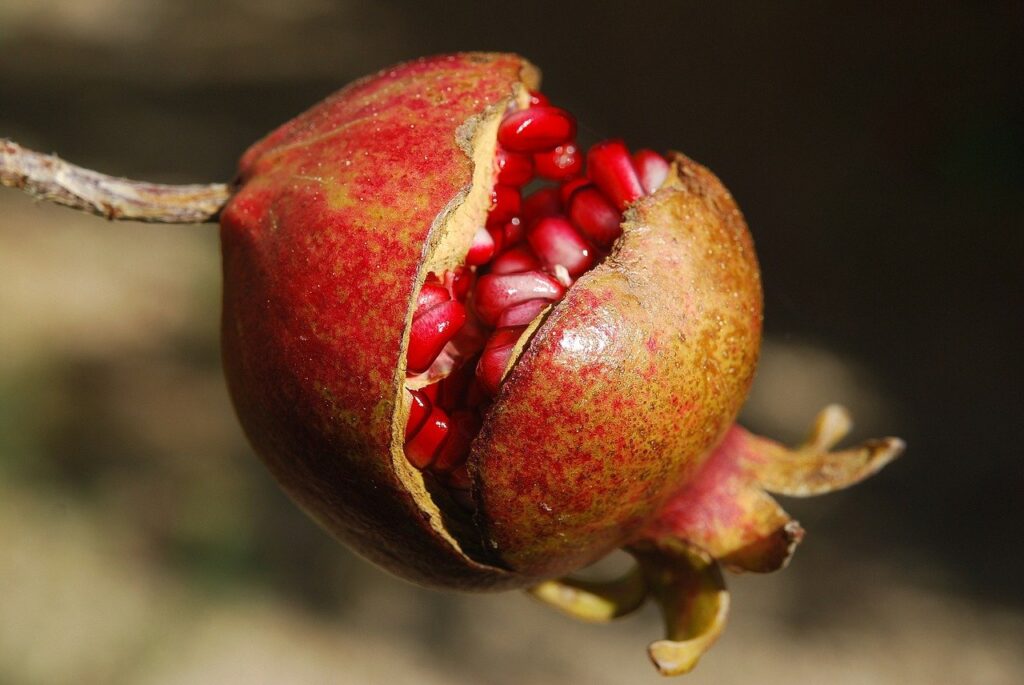
The pomegranate through history
Pomegranate can be found everywhere in history, mythology and religions! It’s considered indigenous to Iran and is an important symbol for Zoroastrianism.
During Shab-e Yalda, the Iranian celebration of the longest and darkest night of the year, pomegranate is eaten to symbolize the victory of light over darkness.
Herodotus also explains how the Persian soldiers had spears with golden and silver pomegranates adorning their spears. And the Babylonians chewed pomegranate seeds before battle.
Painting of pomegranate were found in temples and tombs of Ancient Egypt. Pomegranate was also a food offering found on altars of Ancient Egypt. For everyday life, the Ancient Egyptians used the juice to make wine and the roots to produce medicine.
The pomegranate: a symbol for a lot of religions
In Christianism, the seeds are a symbol for the community and therefore the Church itself. The pomegranate itself is also seen as a symbol of life and resurrection and was associated with the Virgin Mary and Jesus.
In the Middle-Ages, tapestries and paintings would represent unicorns bleeding pomegranate seeds. It was both a symbol of fertility but also a reference to Jesus’s resurrection.
For Judaism, the pomegranate is one of the fruits eaten for Rosh Hashana, the new year celebration taking place in autumn. Eating one seed at a time is a way to get blessings fulfilled.
In Buddhism, Pomegranate is one of the blessed fruits, along with lemon and peach.
The pomegranate is mentioned in the Koran as one of the good things created by God and is sometimes referred as the apple from Heaven. Each pomegranate would hold a seed coming down from Heaven.
Mythology and folklore around the pomegranate
It’s all about power and death
Of, course it’s also found a lot in mythology. The Persian hero, Esfandiyar, became invincible after eating a pomegranate.
The pomegranate is important in Greek mythology as well where it’s known as fruit of the Underworld. When Persephone went to the Underworld after being kidnapped by Hades, the only food she ate was the seeds of a pomegranate (patriarchy thinking you can sustain yourself on a few seeds) and because of that, she couldn’t leave until her mother raised hell.
But the pomegranate is also supposed to be born from Adonis’ blood, making it doubly related to death.
So much talk about fertility!
This being said, it also has a huge connotation with fertility, thanks to the hundreds of seeds that the fruit contains.
Romans would give young brides pomegranate leaves crowns to encourage fertility while the juice of pomegranate was used to cure it.
In China, it was popular to gift representations of open pomegranate to couples who had just wed.
The pomegranate is used traditionally in Bedouins’ weddings as a symbol of fertility. The couple would open the pomegranate right before entering their home and eat many seeds to ensure having children.
The pomegranate: Not just for natural dyeing but also good for your health!
The health benefits of pomegranate:
The pomegranate used as a remedy for centuries:
All the parts of the pomegranate have been used in medicine, including bark and rind. It was already described by Dioscorides who gave recipes against ulcers and painful gums and teeth.
The Ancient Roman had recipes using the rind and the root to treat tapeworms and diarrhoea.
The Ebers Papyrus also showed recipes with the pomegranate to treat tapeworms.
We now know it was also widely used against urinary infections, digestive disorders, and arthritis.
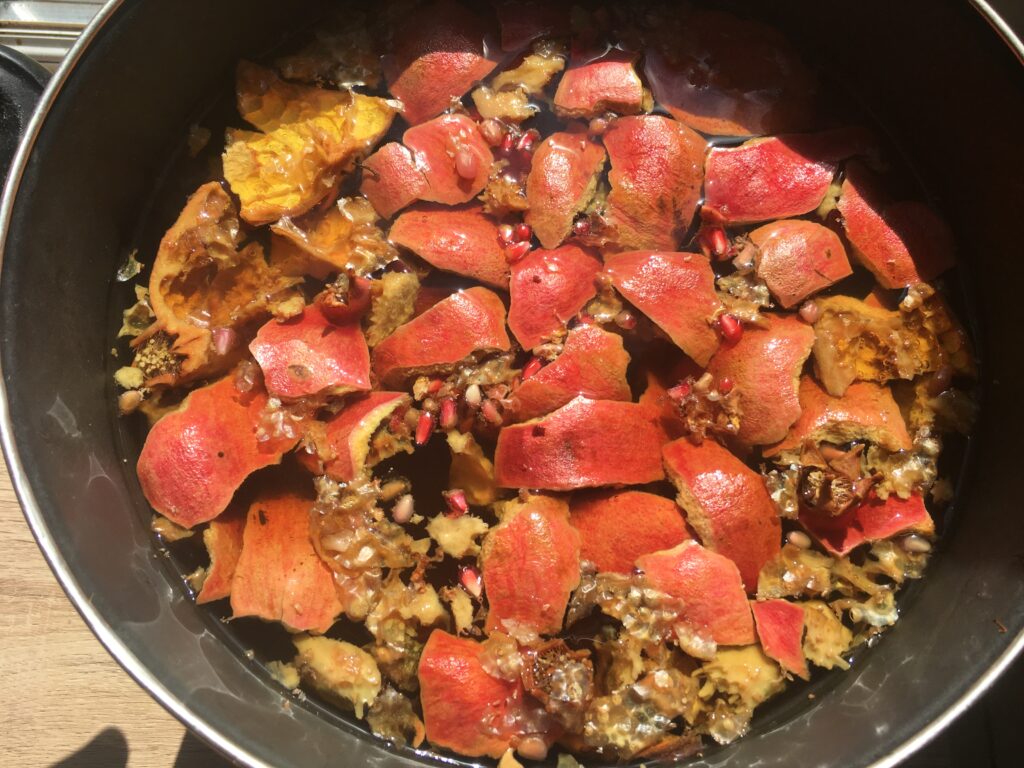
Modern medicine is still proving that this juice is the good stuff!
It contains antioxidants, lots of flavonoids (also one of the compounds for dyeing), phenolic acid which is important for cells regulation but also potassium, vitamins A,C and E, iron and calcium.
Modern research is now proving that pomegranate can help against prostate and skin cancers, osteoarthritis and diabetes. It may also prevent heart diseases and strokes because it increases blood flow to the heart and good cholesterol, reducing blood pressure, bad cholesterol and plaques in the arteries.
The seeds itself can help with cleaning the digestive system from fats and the juice has been used to treat jaundice and diarrhoea.
Alright, another benefit of the pomegranate which is more for naturally dyeing: the tannins
Both the rind and the seeds of the pomegranate are rich in tannins and flavonoids.
Because of its high concentration in tannins (it can have until 26% of tannins in a fruit), the pomegranate can be used without an additional mordant (like alum) for natural dyeing and is particularly suited to plant fibers like cotton or linen.
It makes it the perfect mordant and dye for vegan natural dyeing. But be careful that it’s not a neutral mordant like nutgalls (which will only give a light beige to your fiber when used as a mordant) but produces deep yellows.
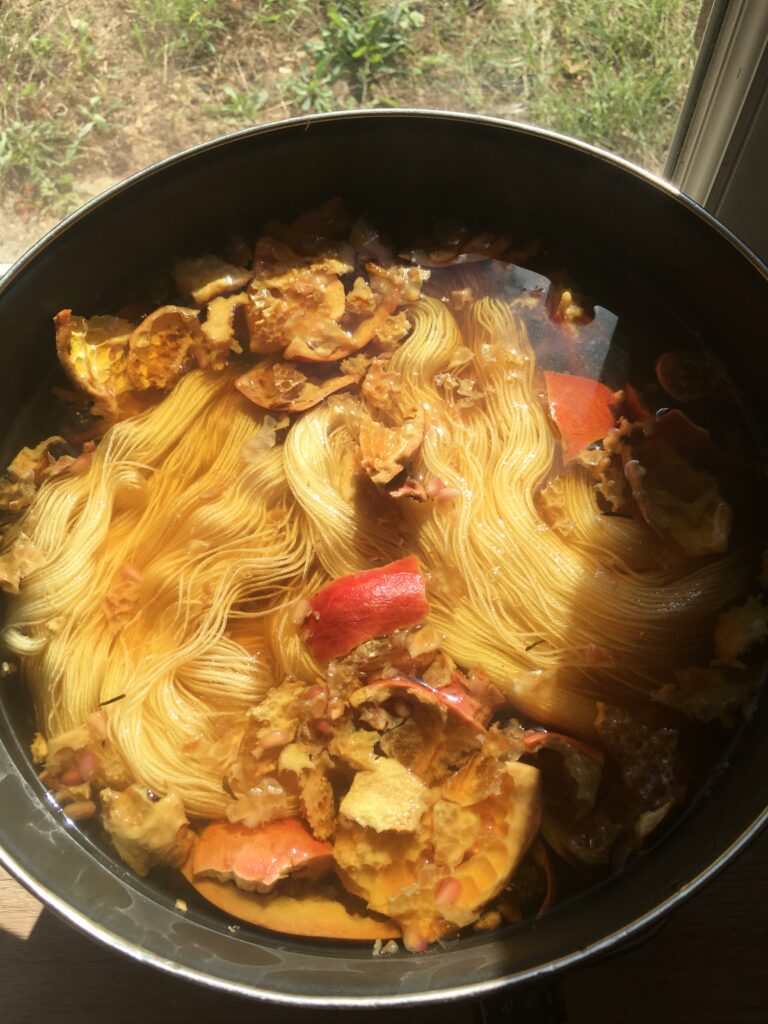
And finally, let’s do some natural dyeing with pomegranate!
A natural dyeing recipe with pomegranate:
Pomegranate produces a vibrant, bright yellow, depending on the maturity of your fruit. I dyed with pomegranates from my aunt’s garden and pomegranates bought at the outdoor market and the ones from my aunt (100% guaranted without pesticides) gave me a yellow almost neon bright, so much that everytime we were holding it, we had to remind ourselves this was part of our natural dyeing collection and not the acid dyes side.
It makes sense that pomegranate was used to get rich yellows on wool, silk and plant fibers. Pomegranate has been also famously used as a natural dye for Oriental carpets since it’s not lightfast like a lot of the yellows produced with natural dyeing.
For realising a project with pomegranate, you will need:
Roughly 100g of pomegranate cut into big chunks. The idea is to get the same weight for the dyestuff and the items to dye. With pomegranate, since we are eating the fruits, I try to add as much as my pot can hold. A little really goes a long way, it’s very generous with the yellow and you can easily do several dye baths with the same batch.
A pot large enough for water, pomegranate and your wool. Keep this pot for dyeing purposes only, especially if you choose to mordant your fibers and don’t use your dyeing material for cooking.
A sieve but it’s really optional with pomegranate. Since it’s small chunks with the occasional seeds, it doesn’t bother me to pick them by hand afterward and there is no pointy end to damage the fiber.
Process for dyeing with pomegranate
Remove your fibers from their mordanted bath, gently remove the excess of water (if you don’t know how to mordant, follow the steps on our post about easy recipes to become a natural dyer.)
Fill a big pot with water then add your pomegranate cut into big chunks.
Heat up the water but don’t let it reach the boiling point.
Let the pot of water and walnut leaves simmer for 1 hour.
Turn the heat off and let it cool down a bit. It’ll give you richer and deeper colors if you leave it the whole night or at least several hours before straining your dye bath.
Now, it’s time to strain your dye bath. Use your sieve or your hands (with gloves) to strain your pomegranate chunks.
Now we have a proper dye bath with, for once, a really nice smell in bonus!
Remove your fibers from their mordanted bath, gently remove the excess of water and let them soak all the color up by immersing them in the dye bath.
Heat up the pot slowly again so it can simmer for about 1 hour.
Let it cool down.
Once again it’s better to leaver your fibers several hours or a whole night in the dye bath. This way, the color will only get deeper.
Once it’s cool down, rinse the fibers in cold water, let it dry and brag about your hard work!
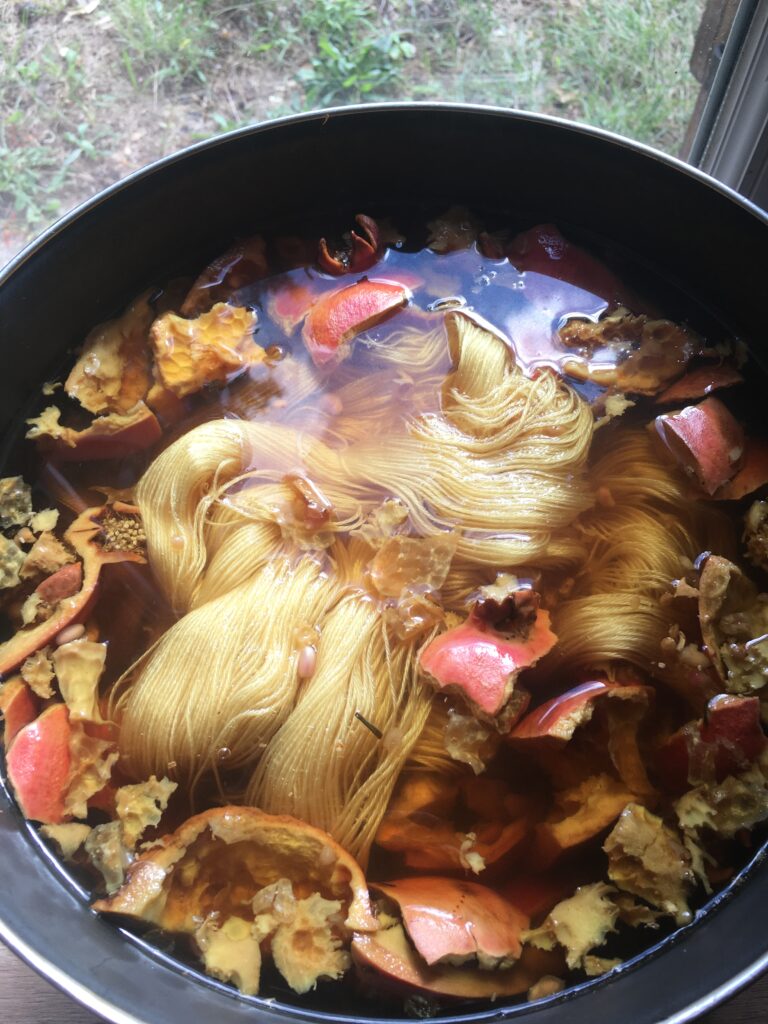
What else can you dye with pomegranate?
Experimenting with colors!
As I said above, you can use pomegranate without a mordant and get great yellows!
Still, keep in mind that your yellow will be deeper, neon bright or golden with a mordant.
If you want to use modifiers, you can also use iron to get grey, green and black. And of course, if you dye your fiber first with pomegranate then with indigo, you will experiment with very cool shades of green.
Eco-printing and painting on paper fibers
Eco-printing with pomegranate
The rind is very popular for eco-printing on fabric. It’s a good way to begin contact-printing since it can be super frustrating at first. You’re assured to get a good colour and some interesting patterns. One of my goals for the near future is to follow a class in eco-printing because my attempts at home were a bit disappointing and it’s so much better to share knowledge and excitement in person, you know?
That’s why I found two recipes for eco-printing that include pomegranates of course, are packed with information and easy to follow.
The first one, from joybileefarm, goes in depth about eco-printing while the second, from madebybarb, is more focused on pomegranate ecodyeing itself.
Painting on paper with pomegranate
Pomegranate can also be used to dye paper, or rather paint on it. Rebecca Desnos explained her process of painting on paper with this article about dyeing paper with natural dyes. She always comes up with interesting and thoughtful ways to incorporate nature in her daily life and turn it into sustainable art.
Hopefully, you liked this addition to dyeing with plants series (two articles make it a series, right!?). It’s really fun to take time to research plants and fruits that we don’t necessarily think at having so many facts and history attached to it. Next time, you will eat a strawberry, maybe you will remember it’s actually a berry when pomegranates and bananas are! (We are still not over how weird it is.)
As you may have guessed it, pomegranate is our focus for this winter because it’s the theme of our new embroidery kit for winter 2021. We are super excited to show you the illustration, the zine and of course the embroidery itself! This time, the pomegranate will be the star with pomegranate dyed vegan cotton skein and a pattern showcasing all sides of this very cool fruit. Let’s take some warmth with us into winter with the bright yellow of the pomegranate!

